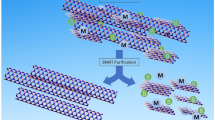Abstract
In this work, the influence of synthesis parameters on the synthesis efficiency of tin oxide nanomaterials was studied by using the carbothermal reduction method in a sealed tube furnace. The parameters were the starting material, temperature and time of synthesis as well as the gas flux. The starting material was tin dioxide mixed with carbon black in a molar proportion of 1.5:1 and 1:1. The temperature range was from 950 to 1,125 °C with a step of 25 °C, and the synthesis times used were 15, 30, 45, 60, 75, 90, and 120 min. Using optimum values of the above parameters, the gas flux was changed to verify its influence. After completion of the syntheses, we found a grayish-black material inside the tube which was characterized by X-ray diffraction and scanning electron microscopy. The results showed that the collected material is composed of nanobelts (with width around 60 nm) and disks that grew preferentially in the SnO phase. A model based on the oxide vapor pressure was proposed to evaluate the efficiency of the process, and the results showed good agreement between experimental data and the proposed model. Based on the results obtained, the best conditions to obtain a homogeneous material with 95% efficiency is using a starting material in the molar proportion Sn:C of 1.5:1, a temperature of 1,132 °C for 75 min, and a N2 gas flux of 80 sccm.







Similar content being viewed by others
References
Antunes AC, Antunes SRM, Zara AJ et al (2002) Effect of Fe2O3 doping on the electrical properties of a SnO2 based varistor. J Mater Sci 37:2407–2411
Chen YX, Campbell LJ, Zhou WL (2004) Self-catalytic branch growth of SnO2 nanowire junctions. J Cryst Growth 270:505
Comini E, Faglia G, Sberveglieri G et al (2005) Tin oxide nanobelts electrical and sensing properties. Sens Actuators B 111:2–6
Dai ZR, Pan ZW, Wang ZL (2002) Growth and structure evolution of novel tin oxide diskettes. J Am Chem Soc 124:8673–8680
Gotoh Y, Fujimura K, Koike M et al (2001) Synthesis of titanium carbide from a composite of TiO2 nanoparticles/methyl cellulose by carbothermal reduction. Mater Res Bull 36:2263–2275
Law M, Sirbuly DJ, Jhonson JC et al (2004) Nanoribbon waveguides for subwavelength photonics integration. Science 305:1269–1273
Leite ER, Gomes JW, Oliveira MM et al (2002) Synthesis of SnO2 nanoribbons by a carbothermal reduction process. J Nanosci Nanotechnol 2:125–128
Li F, Chen L, Chen Z et al (2002) Two-step solid-state synthesis of tin oxide and its gas-sensing property. Mater Chem Phys 73:335–338
Morales AM, Lieber CM (1998) A laser ablation method for the synthesis of crystalline semiconductor nanowires. Science 279:208–211
Orlandi MO, Leite ER, Aguiar R et al (2006) Growth of SnO nanobelts and dendrites by a self-catalytic VLS process. J Phys Chem B 110:6621–6625
Pan ZW, Dai ZR, Wang ZL (2001) Nanobelts of semiconducting oxides. Science 291:1947–1949
Rao MM, Jayalaksmi M, Reedy BR (2005) Recognizing nano SnO as an electrode material for electrochemical double layer capacitors. Chem Lett 34:712–713
Samsonov GV (1973) The oxide handbook. Plenum Press, New York
Shibagaki K, Tanaka N, Sasaki K, Kadota K (2002) Synthesis efficiency of heavy carbon clusters from ETFE ablated by different numbers of laser pulse in vacuum. Appl Surf Sci 197–198:598–602
Shibagaki K, Kamiya Y, Sasaki K (2004) Enhancement of the synthesis efficiency of carbon cluster ions by the irradiation of two laser pulses to polymers in vacuum. Appl Phys A 79:1161–1163
Sun SH, Meng GW, Wang YW et al (2002) Large-scale synthesis of SnO2 nanobelts. Appl Phys A 76:287–289
Wagner RS, Ellis WC (1964) Vapor–liquid–solid mechanism of single crystal growth. Appl Phys Lett 4:89–90
Wang T, Ma ZN, Xu F et al (2003) The one-step preparation and electrochemical characteristics of tin dioxide nanocrystalline materials. Electrochem Commun 5:599–602
Wang SR, Huang J, Zhao YQ et al (2006) Nanostructure SnO2 and supported Au catalysts: synthesis, characterization, and catalytic oxidation of CO. Mater Lett 60:1706–1709
Wu Y, Yang PD (2001) Direct observation of vapor−liquid−solid nanowire growth. J Am Chem Soc 123:3165–3166
Xu CK, Xu GD, Liu YK et al (2002) Preparation and characterization of SnO2 nanorods by thermal decomposition of SnC2O4 precursor. Scr Mater 46:789–794
Zhang Y, Wang N, Gao S et al (2002) A simple method to synthesize nanowires. Chem Mater 14:3564–3568
Zhu HL, Ji X, Yang DR (2006) Hydrothermal synthesis and characterization of novel aloe-like SnS2 nanostructures. J Mater Sci 41:3489–3492
Acknowledgments
The financial backing of the Brazilian agencies Fundunesp and FAPESP are gratefully acknowledged. The FEG-SEM facilities were provided by the LME-LNLS (National Laboratory of Synchrotron Light), Campinas, Brazil.
Author information
Authors and Affiliations
Corresponding author
Rights and permissions
About this article
Cite this article
Suman, P.H., Orlandi, M.O. Influence of processing parameters on nanomaterials synthesis efficiency by a carbothermal reduction process. J Nanopart Res 13, 2081–2088 (2011). https://doi.org/10.1007/s11051-010-9964-8
Received:
Accepted:
Published:
Issue Date:
DOI: https://doi.org/10.1007/s11051-010-9964-8




